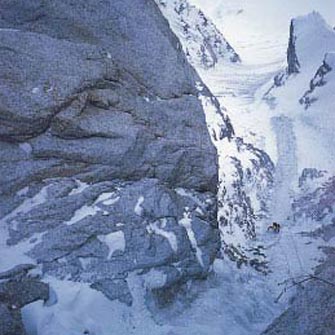
Kelly “Junior” Cordes follows through the first rock band on Going Monk (V AI6 M6, 4,300′), Peak 13,790′, Alaska Range, Alaska. [Photo] Jonathon Copp
On May 30, Jonny Copp and I climbed a new route from the south side of the crevasse- and serac-riddled East Fork of the Kahiltna Glacier in a twenty-four-hour, round-trip push from the base. We climbed with light daypacks and, aside from the two crux pitches, simulclimbed throughout. Going Monk (AI6 M6) rises 4,300 vertical feet to the summit of Peak 13,790′, which may have been previously unclimbed. We propose that this peak be named “Mt. Andrews” for our friend Bruce Andrews, who was on our minds constantly after his death two days earlier in a tragic airplane crash on a nearby glacier.
Toward the end of the ten-mile ski approach from the Kahiltna International Base Camp, we erected our tent for a preclimb rest and brew. Hidden from view until near the base, a striking ribbon of ice arises from the north-facing snow- and icefield that breaks the rock wall on the peak’s west end. Hollow, gently overhanging alpine ice on the first pitch of this ice strip provided one of the route’s cruxes.
The ribbon rolled on above with superb climbing, depositing us on ice slopes from which we climbed directly up the west ridge through two prominent rock towers. The towers (which easily could be avoided on less-interesting ice slopes) yielded some outstanding, moderate mixed climbing with a few scrappy spots and the route’s other crux pitch, a thinly-iced corner on the first tower.
High on the route, with easy climbing remaining to the summit ridge, we continued on; though we were dehydrated, tired and the forecast storm was imminent, taking the time to stop and brew seemed foolish. We reached the ridge in a whiteout and staggered upward along the seemingly endless, crevassed ridge, because our efforts just wouldn’t have meant as much to us without finishing. Occasional brief glimpses through the swirling clouds disappointed us with the realization that we had farther to go. Finally, fifteen hours after starting, we stood on the summit, then hastily retreated, rappeling through increasingly wet snowfall.
While skiing away amid snow and a fog of exhaustion, I plunged through a shallow bridge into a completely hidden crevasse that ran parallel to our direction of travel. It was, by far, the most terrifying part of our adventure, and the bottomless abyss looked like a horrible place to spend the rest of my life. I was still trembling when we crawled into the tent to huddle together like soggy trolls for a few hours’ snoozing before finishing the ski out.
— Kelly Cordes, Estes Park, Colorado, USA